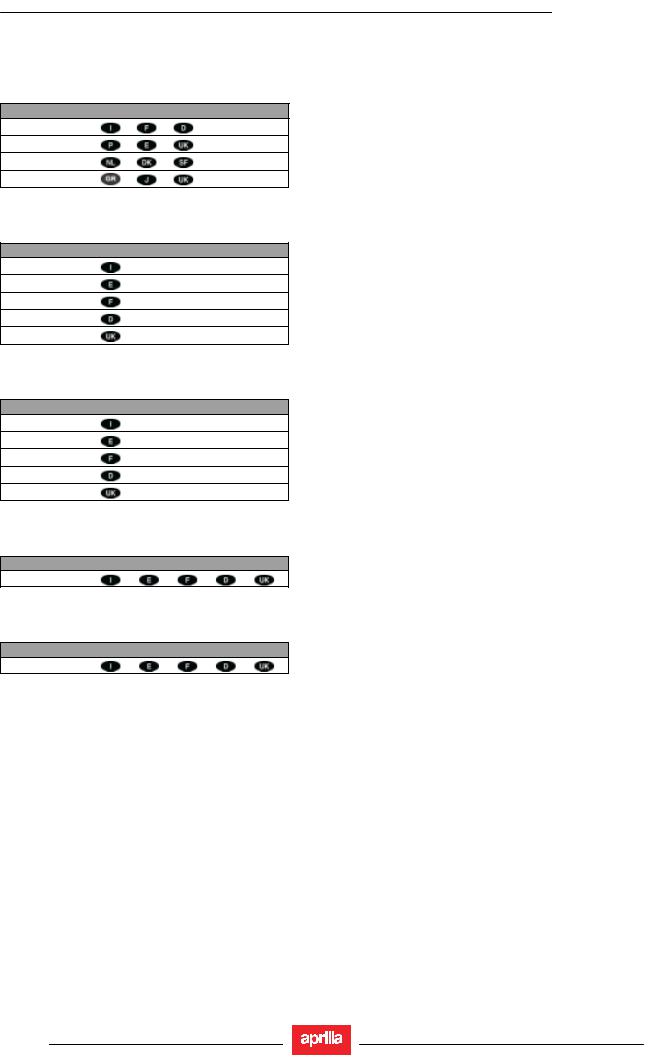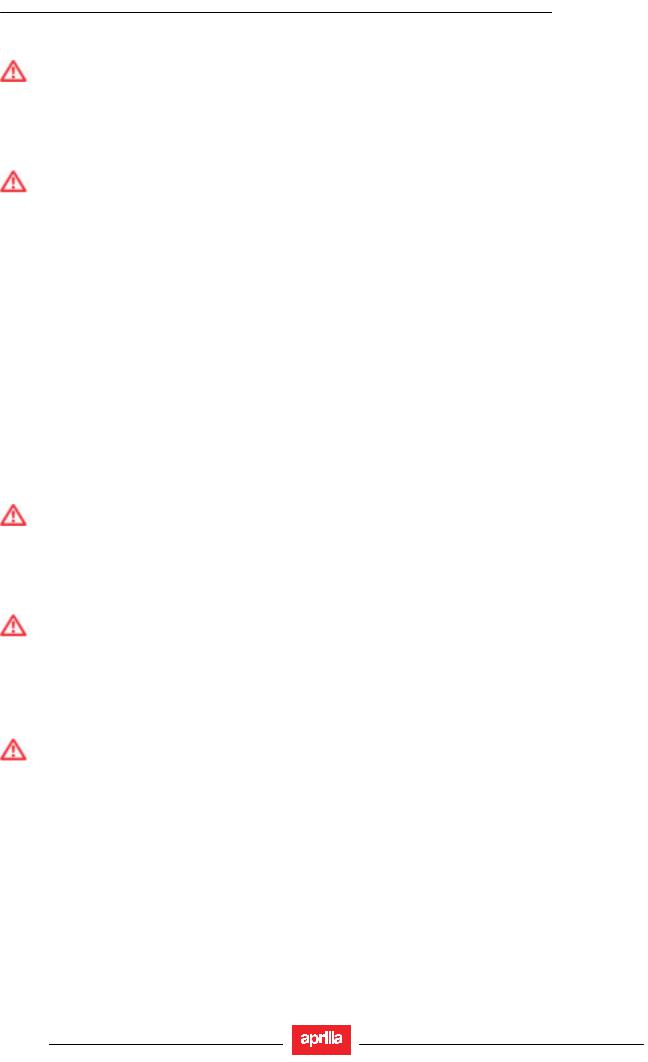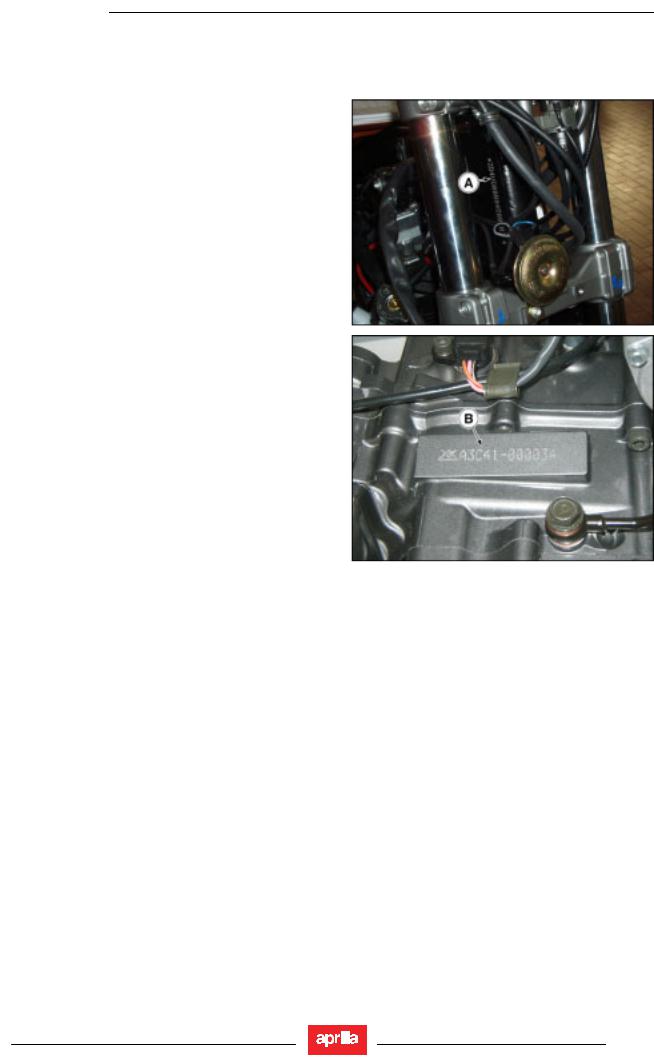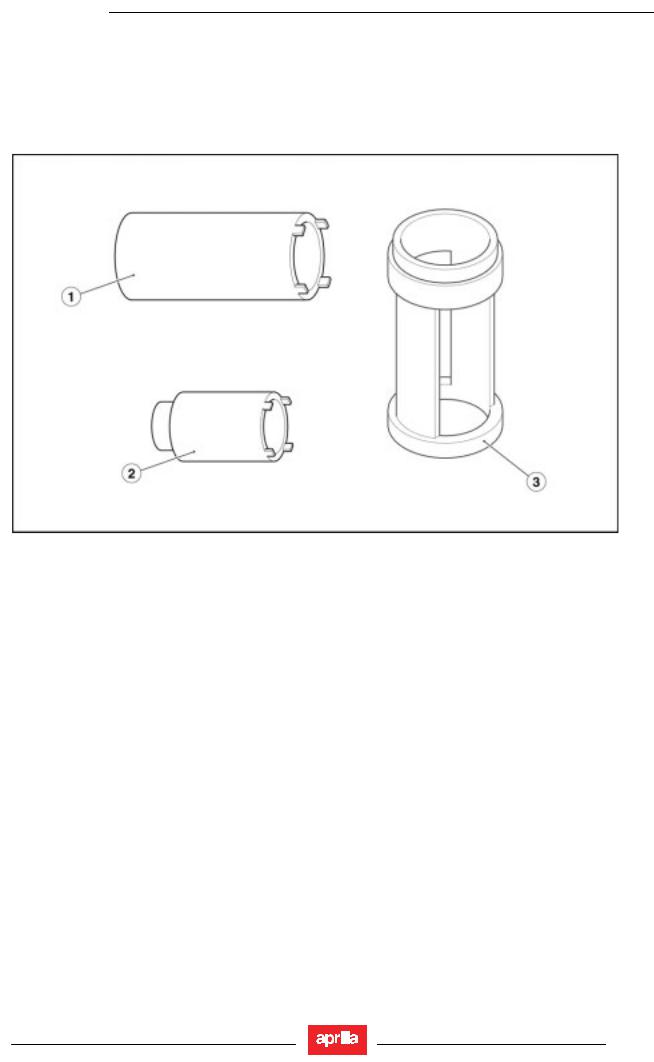Aprilia Pegaso 650 2005 Owner's manual

INTRODUCTION
PEGASO 650
INTRODUCTION |
0 |
0 - 1

INTRODUCTION |
|
|
|
|
PEGASO 650 |
|
SUMMARY |
|
0.1. INTRODUCTION .............................................................................................................................................. |
3 |
|
0.1.1. |
FOREWORD ............................................................................................................................................. |
3 |
0.1.2. |
REFERENCE MANUALS .......................................................................................................................... |
4 |
0.1.3. |
ABBREVIATIONS/SYMBOLS/CONVENTIONS ........................................................................................ |
5 |
0 - 2

INTRODUCTION
PEGASO 650
0.1.INTRODUCTION
0.1.1.FOREWORD
This manual provides the information required for normal servicing.
This publication is intended for use by aprilia Dealers and their qualified mechanics; many concepts have been omitted on purpose as their inclusion would be superfluous. Since complete mechanical explanations have not been included in this manual, the reader must be familiar with basic notions of mechanics, as well as with basic repair procedures. Without such familiarity, repairs and checks could be ineffective and even hazardous. Since the repair and vehicle check instructions are not exhaustive, special care must be taken to avoid damage and injury. To ensure maximum customer satisfaction with the vehicle, aprilia s.p.a. continuously improves its products and their documentation. The main technical modifications and changes in repair procedures are communicated to all aprilia dealers and agencies worldwide. Such modifications will be entered in subsequent editions of the manual. Should you need assistance or clarifications about the inspection and repair procedures, please contact the aprilia SERVICE DEPT., they will be glad to give you any information on the matter, or supply you with any detail on updates and technical changes applied to the vehicle.
aprilia s.p.a. reserves the right to make changes to its products at any time, barring any such changes as may alter the essential features of a product as specified in the relevant manual.
All rights of storage using electronic means, reproduction and total or partial adaptation, whatever the means adopted, are reserved in all countries.
Third parties' products are only mentioned for information purposes, and constitute no engagement. aprilia s.p.a. is not liable in any way for the performance or use of these products.
First edition: April 2005
Produced and printed by:
DECA s.r.l.
via Vincenzo Giardini, 11 - 48022 Lugo (RA) - Italy Tel. +39 - 0545 216611
Fax +39 - 0545 216610 E-mail: deca@vftis.spx.com www.vftis.com
on behalf of:
aprilia s.p.a.
via G. Galilei, 1 - 30033 Noale (VE) - Italy Tel. +39 – (0)41 58 29 111
Fax +39 – (0)41 58 29 190 www.aprilia.com www.serviceaprilia.com
0 - 3

INTRODUCTION
PEGASO 650
0.1.2. REFERENCE MANUALS
OWNER'S MANUALS
aprilia part# (description)
8104896
8104895
8104897
8104894
CHASSIS WORKSHOP MANUAL
aprilia part# (description)
8140874
8140877
8140875
8140876
8140878
ENGINE TECHNICAL MANUAL
aprilia part# (description)
8140880
8140883
8140881
8140882
8140884
CD FOR THE NETWORK - ENGINE
aprilia part# (description)
8CM0086
CD FOR THE NETWORK - CHASSIS
aprilia part# (description)
8CM0084
0 - 4

INTRODUCTION
PEGASO 650
0.1.3.ABBREVIATIONS/SYMBOLS/CONVENTIONS
#= number
<= less than
>= greater than
≤= less than or equal to
≥= more than or equal to
~= approximately
∞= infinity
°C |
= degrees Celsius (centigrade) |
°F |
= degrees Fahrenheit |
±= plus or minus
a.c |
= alternating current |
A= Ampere
Ah |
= Ampere per hour |
API |
= American Petroleum Institute |
AT |
= high voltage |
AV/DC |
= Anti-Vibration Double Countershaft |
bar |
= pressure measurement unit (1 bar = 100 kPa) |
d.c. |
= direct current |
cc |
= cubic centimetres |
CO |
= carbon monoxide |
CPU |
= Central Processing Unit |
DIN |
= German industrial standards (Deutsche Industrie Norm) |
DOHC |
= Double Overhead Camshaft |
ECU |
= Electronic Control Unit |
rpm |
= revolutions per minute |
HC |
= unburnt hydrocarbons |
ISC |
= Idle Speed Control |
ISO |
= International Standardisation Organisation |
kg |
= kilograms |
kgm |
= kilograms per metre (1 kgm = 10 Nm) |
km |
= kilometres |
km/h |
= kilometres per hour |
kΩ |
= kilo Ohm |
kPa |
= kiloPascal (1 kPa = 0.01 bar) |
KS |
= clutch side (from the German "Kupplungsseite") |
kW |
= kilowatt |
ℓ= litres
LAP |
= racetrack lap |
LED |
= Light Emitting Diode |
LEFT |
|
SIDE |
= left side |
m/s |
= metres per second |
max |
= maximum |
mbar |
= millibar (1 mbar = 0.1 kPa) |
mi |
= miles |
MIN |
= minimum |
MPH |
= miles per hour |
MS |
= flywheel side (from the German "Magnetoseite") |
MΩ |
= MegaOhm |
N.A. |
= Not Available |
N.O.M.M. |
= Motor Octane Number |
N.O.R.M. |
= Research Octane Number |
Nm |
= Newton metre (1 Nm = 0.1 kgm) |
Ω= ohm
PICK-UP |
= pick-up |
BDC |
= Bottom Dead Centre |
TDC |
= Top Dead Centre |
PPC |
= Pneumatic Power Clutch |
0 - 5

INTRODUCTION |
|
|
||
PEGASO 650 |
||||
RIGHT |
|
|
||
|
|
|
||
|
|
|
||
SIDE |
= right side |
|||
SAE |
= Society of Automotive Engineers |
|||
TEST |
= diagnostic check |
|||
T.B.E.I. |
= crown-head Allen screw |
|||
T.C.E.I. |
= cheese-head Allen screw |
|||
T.E. |
= hexagonal head |
|||
T.P. |
= flat head screw |
|||
TSI |
= Twin Spark Ignition |
|||
UPSIDE- |
|
|
|
|
DOWN |
= inverted fork |
|||
V= volt
W |
= watt |
Ø= diameter
0 - 6

GENERAL INFORMATION
PEGASO 650
GENERAL INFORMATION |
1 |
1 - 1

GENERAL INFORMATION |
|
|||
PEGASO 650 |
||||
|
|
SUMMARY |
||
|
|
|
||
|
|
|
||
1.1. STRUCTURE OF THE MANUAL...................................................................................................................... |
3 |
|||
1.1.1. CONVENTIONS USED IN THE MANUAL ................................................................................................. |
3 |
|||
1.1.2. |
SAFETY WARNINGS ................................................................................................................................ |
4 |
||
1.2. |
GENERAL RULES............................................................................................................................................ |
5 |
||
1.2.1. |
BASIC SAFETY RULES ............................................................................................................................ |
5 |
||
1.3. |
DANGEROUS ELEMENTS............................................................................................................................... |
8 |
||
1.3.1. |
WARNINGS ............................................................................................................................................... |
8 |
||
1.4. |
RUNNING-IN .................................................................................................................................................. |
12 |
||
1.4.1. |
RUNNING-IN ........................................................................................................................................... |
12 |
||
1.5. |
VEHICLE IDENTIFICATION ........................................................................................................................... |
13 |
||
1.5.1. POSITION OF THE SERIAL NUMBERS ................................................................................................. |
13 |
|||
1 - 2

GENERAL INFORMATION
PEGASO 650
1.1.STRUCTURE OF THE MANUAL
1.1.1.CONVENTIONS USED IN THE MANUAL
•This manual is divided in sections and subsections, each covering a set of the most significant components. Refer to the index of sections when consulting the manual.
•Unless expressly specified otherwise, assemblies are reassembled by reversing the dismantling procedure.
•The terms "right" and "left" are referred to the rider seated on the vehicle in the normal riding position.
•Motorcycle operation and basic maintenance are covered in the "OWNER'S MANUAL".
In this manual any variants are identified with these symbols:
optional
catalytic version
-all versions
MP |
national certification |
|
|
SF |
European certification (EURO 2 limits) |
|
|
VERSION: |
|
|
|
|
Italy |
Greece |
Malaysia |
|
United |
Holland |
Chile |
|
Kingdom |
|
|
|
Austria |
Switzerland |
Croatia |
|
Portugal |
Denmark |
Australia |
|
Finland |
Japan |
United |
|
|
|
States of |
|
|
|
America |
|
Belgium |
Singapore |
Brazil |
|
Germany |
Slovenia |
South Africa |
|
France |
Israel |
New |
|
|
|
Zealand |
|
Spain |
South |
Canada |
|
|
Korea |
|
1 - 3

GENERAL INFORMATION
PEGASO 650
1.1.2.SAFETY WARNINGS
The following precautionary warnings are used throughout this manual in order to convey the following messages:
Safety warning. This symbol appears, whether in the manual or on the vehicle itself, to indicate a personal injury hazard. Non-compliance with the indications given in the messages preceded by this symbol may result in serious risks for your and other people’s safety and for the vehicle!
DANGER
Indicates a potential hazard which may result in serious injury or even death.
WARNING
Indicates a potential hazard which may result in minor personal injury or damage to the vehicle.
NOTE The word "NOTE" in this manual precedes important information or instructions.
1 - 4

GENERAL INFORMATION
PEGASO 650
1.2.GENERAL RULES
1.2.1.BASIC SAFETY RULES
CARBON MONOXIDE
Should it be necessary to perform some operations with the vehicle running, make sure to work outdoors or in a wellaerated room.
Avoid starting the engine indoors.
In case you are working indoors, use a gas exhaust system.
DANGER
Exhaust gases contain carbon monoxide, which is extremely toxic if inhaled and may cause loss of consciousness or even lead to death.
FUEL
DANGER
The fuel used in internal combustion engines is highly flammable and can become explosive under particular conditions.
Refuelling and engine service should take place in a well-ventilated area with the engine stopped. Do not smoke when refuelling or in the proximity of sources of fuel vapours, avoid flames, sparks and any element that could ignite fuel or provoke explosions.
DO NOT DISPOSE OF FUEL IN THE ENVIRONMENT.
KEEP AWAY FROM CHILDREN.
HIGH-TEMPERATURE COMPONENTS
The engine and the components of the exhaust system become very hot and remain hot for some time after the engine has been stopped.
Before handling these components, wear insulating gloves or wait until the engine and the exhaust system have cooled down.
USED GEARBOX AND FORK FLUIDS
DANGER
Wear latex gloves when servicing.
Gear fluid may cause serious damage to the skin if handled daily and for long periods. Wash your hands carefully after handling engine oil.
Take it to the filling station where you usually buy it or to an oil salvage centre. Wear latex gloves when servicing.
DO NOT DISPOSE OF FLUID IN THE ENVIRONMENT
KEEP AWAY FROM CHILDREN.
BRAKE FLUID
WARNING
When handling the brake fluid, take care not to spill it on the plastic, rubber or painted parts, since it can damage them. When carrying out the maintenance operations on the braking system, use a clean cloth to cover these parts.
Always wear safety goggles when working on the braking system. The brake fluid is highly irritant. Avoid contact with your eyes.
If the brake fluid gets in contact with your eyes, carefully wash them with fresh water and immediately seek medical advice.
KEEP AWAY FROM CHILDREN.
COOLANT
Coolant contains ethylene glycol that is flammable, under certain conditions. When ignited, ethylene glycol produces invisible flames that might cause burns.
1 - 5

GENERAL INFORMATION
PEGASO 650
DANGER
Take care not to spill coolant onto hot engine parts and exhaust system. It may ignite and produce invisible flames.
Wear latex gloves when servicing.
Although toxic, it has a sweet taste that might attract animals. Never leave coolant in open container or in a position easily reachable by animals.
KEEP AWAY FROM CHILDREN.
Do not remove radiator cap when engine is still hot. Coolant is under pressure and might cause burns.
HYDROGEN GAS AND BATTERY ELECTROLYTE
DANGER
The battery electrolyte is a toxic, caustic substance containing sulphuric acid and thus able to cause severe burns in case of contact with the skin.
Always wear tight gloves and protective clothes when handling this fluid. In case of contact with skin, rinse with plenty of fresh water.
Always use a protection for your eyes since even a very small amount of the battery fluid can cause blindness. In the event of contact with your eyes, carefully wash them with water for fifteen minutes and then consult immediately an eye specialist.
Should you accidentally drink some fluid, drink abundant water or milk, then drink magnesia milk or vegetable oil and immediately seek medical advice.
The battery gives off explosive gases and must be kept away from flames and sources of ignition or heat; do not smoke near the battery.
KEEP AWAY FROM CHILDREN.
Battery fluid is corrosive.
Do not spill it, especially on plastic parts.
Make sure that the electrolyte acid is suitable for the type of battery used.
GENERAL PRECAUTIONS AND INFORMATION
Follow these instructions closely when repairing, disassembling or reassembling the motorcycle or its components.
DANGER
Using bare flames is strictly forbidden when working on the motorcycle. Before servicing or inspecting the motorcycle: stop the engine and remove the key from the ignition switch; allow for the engine and exhaust system to cool down; where possible, lift the motorcycle using adequate equipment placed on firm and level ground. Be careful of any parts of the engine or exhaust system which may still be hot to the touch to avoid scalds or burns.
Do not put any vehicle parts into your mouth: vehicle components are not edible and some of them are harmful or even toxic.
Unless expressly specified otherwise, assemblies are reassembled by reversing the dismantling procedure. Where a procedure is cross-referred to relevant sections in the manual, proceed sensibly to avoid disturbing any parts unless strictly necessary. Do not polish matt-painted surfaces with polishing paste.
Never use fuel instead of solvent to clean the motorcycle.
Do not clean any rubber or plastic parts or the seat with alcohol, petrol or solvents. Clean with water and mild detergent.
Always disconnect the battery negative (-) lead before soldering any electrical components.
When two or more persons service the same motorcycle together, special care must be taken to avoid personal injury.
BEFORE DISASSEMBLING ANY COMPONENTS
•Clean off all dirt, mud, and dust and clear any foreign objects from the vehicle before disassembling any components.
•Use the model-specific special tools where specified.
1 - 6

GENERAL INFORMATION
PEGASO 650
DISASSEMBLING THE COMPONENTS
-Never use pliers or similar tools to slacken and/or tighten nuts and bolts. Always use the suitable spanner.
-Mark all connections (hoses, wiring, etc.) with their positions before disconnecting them. Identify each connection using a distinctive symbol or convention.
-Mark each part clearly to avoid confusion when refitting.
-Thoroughly clean and wash any components you have removed using a detergent with low flash point.
-Mated parts should always be refitted together. These parts will have seated themselves against one another in service as a result of normal wear and tear and should never be mixed up with other similar parts on refitting.
-Certain components are matched-pair parts and should always be replaced as a set.
-Keep away from heat sources.
REASSEMBLING THE COMPONENTS
DANGER
Never reuse a circlip or snap ring. These parts must always be renewed once they have been disturbed.
When fitting a new circlip or snap ring, take care to move the open ends apart just enough to allow fitment to the shaft.
Make it a rule to check that a newly-fitted circlip or snap ring has located fully into its groove. Never clean a bearing with compressed air.
NOTE All bearings must rotate freely with no hard spots or noise. Replace any bearings that do not meet these requirements.
-Use ORIGINAL aprilia SPARE PARTS only.
-Use the specified lubricants and consumables.
-Where possible, lubricate a part before assembly.
-When tightening nuts and bolts, start with the largest or innermost nut/bolt and observe a cross pattern. Tighten evenly, in subsequent steps until achieving the specified torque.
-Replace any self-locking nuts, gaskets, seals, circlips or snap rings, O-rings, split pins, bolts and screws which have a damaged thread.
-Lubricate the bearings abundantly before assembly.
-Make it a rule to check that all components you have fitted are correctly in place.
-After repairing the motorcycle and after each service inspection, perform the preliminary checks, and then test ride the motorcycle in a private estate area or in a safe area away from traffic.
-Clean all mating surfaces, oil seal edges and gaskets before assembly. Apply a thin layer of lithium grease along the edges of oil seals. Fit oil seals and bearings with the marking or serial number facing outwards (in view).
ELECTRICAL CONNECTORS
To disconnect the electrical connectors, follow the procedures below. Failure to comply with these procedures may lead to irreparable damage to the connector and the wiring as well.
If present, press the special safety hooks.
WARNING
Do not pull cables to disconnect the two connectors.
•Grasp the two connectors and disconnect them by pulling them in the two opposite directions.
•In case of dirt, rust, moisture, etc., thoroughly clean the inside of the connectors with compressed air.
•Make sure that the cables are correctly fitted inside the connector terminals.
NOTE The two connectors have just one correct positioning. Make sure to position them in the right direction.
•Then fit the two connectors. Make sure they are correctly coupled (a click will be heard if hooks are present).
TIGHTENING TORQUE SETTINGS
DANGER
Always remember that the tightening torque settings of all wheel, brake, wheel shaft and other suspension parts play a fundamental role to ensure vehicle safety. Make sure that these values are always within the specified limits.
Check fastening parts tightening torque settings at regular intervals. Upon reassembly, always use a torque wrench.
Failure to comply with these recommendations could lead to the loosening and detachment of one of these parts with a consequent locking of the wheel or other serious troubles affecting the vehicle manoeuvrability, and thus the risk of falls and serious injuries or death.
1 - 7

GENERAL INFORMATION
PEGASO 650
1.3.DANGEROUS ELEMENTS
1.3.1. WARNINGS
FUEL
DANGER
The fuel used to operate engines is highly flammable and becomes explosive under particular conditions.
Refuelling and engine service should take place in a well-ventilated area with the engine stopped.
Do not smoke when refuelling or in the proximity of sources of fuel vapours, avoid flames, sparks and any element that could ignite fuel or provoke explosions.
Take care not to spill fuel out of the filler, or it may ignite when in contact with hot engine parts.
In the event of accidental fuel spillage, make sure the affected area is fully dry before starting the engine. Fuel expands from heat and when left under direct sunlight.
Never fill the fuel tank up to the brim. Tighten the filler cap securely after each refuelling.
Avoid contact with skin. Do not inhale vapours. Do not swallow fuel. Do not transfer fuel between different containers using a hose.
DO NOT DISPOSE OF FUEL IN THE ENVIRONMENT. KEEP AWAY FROM CHILDREN.
Use only premium grade unleaded petrol, min. O.N. 95 (RON) and 85 (MON).
LUBRICANTS
DANGER
A good lubrication ensures the vehicle safety.
Failure to keep the lubricants at the recommended level or the use of a non-suitable new and clean type of lubricant can lead to the engine or gearbox seizure, thus causing serious accidents, personal injury or even death.
Gear fluid may cause serious damage to the skin if handled daily and for long periods. Wash your hands carefully after use.
Do not dispose of oil in the environment.
Take it to the filling station where you usually buy it or to an oil salvage centre.
WARNING
When filling the vehicle with this oil, take care not to spill it out. Immediately clean spilt oil, or it might damage the vehicle paintwork.
In case of contact with oil, the tyres surface will become very slippery, thus becoming a serious danger for your safety.
In case of leaks, do not use the vehicle. Check and trace the cause of leaks and proceed to repair.
ENGINE OIL
DANGER
Engine oil may cause serious damage to the skin if handled daily and for long periods. Wash your hands carefully after use.
Do not dispose of oil in the environment.
Dispose of engine oil through the nearest waste oil reclamation firm or through the supplier. Wear latex gloves when servicing.
FRONT FORK FLUID
DANGER
Front suspension response can be modified to a certain extent by changing damping settings and/or selecting a particular grade of oil. Standard oil viscosity: SAE 20 W. Different oil grades can be selected to obtain a particular suspension response (choose SAE 5W for a softer suspension, 20W for a stiffer suspension).
The two grades can also be mixed in varying solutions to obtain the desired response.
1 - 8

GENERAL INFORMATION
PEGASO 650
BRAKE FLUID
NOTE This vehicle is fitted with front and rear disc brakes. Each braking system is operated by an independent hydraulic circuit. The information provided below applies to both braking systems.
DANGER
Do not use the vehicle in case brakes are worn out or do not work properly. The brakes are the parts that most ensure your safety and for this reason they must always be perfectly working. Failure to comply with these recommendations will probably lead to a crash or an accident, with a consequent risk of personal injury or death.
A wet surface reduces brakes efficiency.
DANGER
In case of wet ground the braking distance will be doubled, since both brakes and tyre grip on the road surface are extremely reduced by the water present on the road surface.
Any water on brakes, after washing the vehicle or driving on a wet road surface or crossing puddles or gips, can wet brakes so as to greatly reduce their efficiency.
Failure to comply with these recommendations may lead to serious accidents, with a consequent risk of severe personal injuries or death.
Brakes are critical safety components. Do not ride the vehicle in case brakes are not working at their best.
Check for brakes proper operation before every trip. Brake fluid is an irritant. Avoid contact with eyes or skin.
In the event of accidental contact, wash affected body parts thoroughly. In the event of accidental contact with eyes, contact an eye specialist or seek medical advice.
DO NOT RELEASE BRAKE FLUID INTO THE ENVIRONMENT. KEEP AWAY FROM CHILDREN.
When handling brake fluid, take care not to spill it onto plastic or paint-finished parts or they will damage.
DANGER
Do not use any brake fluids other than the specified type. Never mix different types of fluids to top up level, as this will damage the braking system.
Do not use brake fluid from containers which have been kept open or in storage for long periods.
Any sudden changes in play or hardness in the brake levers are warning signs of problems with the hydraulic circuits.
Ensure that the brake discs and brake linings have not become contaminated with oil or grease. This is particularly important after servicing or inspections.
Make sure the brake lines are not twisted or worn.
Prevent accidental entering of water or dust into the circuit. Wear latex gloves when servicing the hydraulic circuit.
DISC BRAKES
DANGER
The brakes are the parts that most ensure your safety and for this reason they must always be perfectly working; check them before every trip.
A dirty disc soils the pads.
Dirty pads must be replaced, while dirty discs must be cleaned with a high-quality degreaser.
Perform the maintenance operations with half the indicated frequency if the vehicle is used in rainy or dusty areas, on uneven surfaces or for racing.
Check brake pads for wear.
When the brake pads wear out, the level of the fluid decreases to automatically compensate for their wear.
The front brake fluid reservoir is located on the right handlebar, near the front brake lever. The rear brake fluid reservoir is located under the right fairing.
Do not use the vehicle if the braking system leaks fluid.
1 - 9

GENERAL INFORMATION
PEGASO 650
COOLANT
DANGER
Coolant is toxic when ingested, contact with eyes or skin may cause irritation.
In the event of contact with your skin or eyes, rinse repeatedly with abundant water and seek medical advice. In the event of ingestion, induce vomiting, rinse mouth and throat with abundant water and seek medical advice immediately.
DO NOT RELEASE INTO THE ENVIRONMENT. KEEP AWAY FROM CHILDREN.
DANGER
Take care not to spill coolant onto hot engine parts. It may ignite and produce invisible flames. Wear latex gloves when servicing. Do not ride when coolant is below the minimum level.
Coolant mixture is a 50% solution of water and antifreeze. This is the ideal solution for most operating temperatures and provides good corrosion protection.
This solution is also suited to the warm season, as it is less prone to evaporative loss and will reduce the need for topups.
In addition, less water evaporation means fewer minerals salts depositing in the radiator, which helps preserve the efficiency of the cooling system.
When the temperature drops below zero degrees centigrade, check the cooling system frequently and add more antifreeze (up to 60% maximum) to the solution, if needed.
Use distilled water in the coolant mixture. Tap water will damage the engine.
Refer to the chart given below and add water with the quantity of antifreeze to obtain a solution with the desired freezing point:
Freezing point °C |
Coolant % of volume |
-20° |
35 |
-30° |
45 |
-40° |
55 |
NOTE Coolants have different specifications. The protection degree is written on the label.
WARNING
Use nitrite-free coolant only, with a protection until at least -35°C.
DRIVE CHAIN
Check drive chain operation, wear, slack and lubrication at regular intervals.
The vehicle is equipped with an endless chain with a joint link.
WARNING
If too slack, the chain can come off the front or rear sprockets thus leading to serious accidents and damage to the vehicle, with consequent serious personal injury or death.
Do not use the vehicle if the chain slack has not been correctly adjusted.
To check the chain, take it with your hand where it turns on the rear sprocket and pull it as to separate it from the sprocket itself.
If you can move the chain apart of the front sprocket for more than 3 mm (0.125 in), change chain, front and rear sprocket.
DANGER
If not properly maintained, chain can early wear out and lead to the damage of both front and rear sprockets.
Perform chain maintenance operations more frequently if the vehicle is used on dusty or muddy areas.
1 - 10

GENERAL INFORMATION
PEGASO 650
TYRES
WARNING
If tyres are excessively inflated, the vehicle will be hard, difficult and uncomfortable to ride.
In addition, the roadworthiness, mainly on wet surfaces and during cornering, will be impaired. Flat tyres (insufficient pressure) can slip on the rim and make you lose the control of the vehicle.
In this case too, both vehicle roadworthiness, manoeuvrability and brake efficiency will be impaired. Tyres changing, repair, maintenance and balancing must be carried out by specialized technicians using suitable equipment.
When new, tyres can have a thin slippery protective coating. Drive carefully for the first kilometres (miles).
Never use rubber treating substances on tyres.
In particular, avoid contact with fluid fuels, leading to a rapid wear. In case of contact with oil or fuel, do not clean but change the tyres.
DANGER
Some of the factory-assembled tyres of this vehicle are provided with wear indicators. There are several kinds of wear indicators.
For more information on how to check the wear, contact your Dealer. Visually check if the tyres are worn and in this case have them changed. If a tyre deflates while driving, stop immediately.
Avoid hard brakings or moves and do not close throttles too abruptly.
Slowly close the throttle grip, move to the edge of the road and use the engine brake to slow down until coming to a halt.
Failure to comply with these recommendations may lead to accidents, with a consequent risk of personal injuries or death.
Do not install tyres with air tube on rims for tubeless tyres and vice versa.
1 - 11

GENERAL INFORMATION
PEGASO 650
1.4.RUNNING-IN
1.4.1.RUNNING-IN
Correct engine running-is essential to ensuring proper performance and durability.
If possible, drive on hilly roads and/or roads with many bends, so that the engine, the suspensions and the brakes undergo a more effective running-in.
During running-in, change speed.
In this way the components are first "loaded" and then "relieved" and the engine parts can thus cool down. Even if it is important to stress the engine components during running-in, take care not to exceed.
WARNING
Only after the first 2000 km (1250 mi) of running-in is it possible to obtain the best acceleration performance from the vehicle.
Keep to the following indications:
•Do not open the throttle completely if the speed is low, both during and after running-in.
•During the first 500 km (312 mi) pull the brakes with caution, avoiding sharp and prolonged brakings. This ensures a correct bedding-in of the pads on the brake discs.
•During the first 500 km (312 mi), never exceed 4000 rpm (see table).
•From 500 km (312 mi) up to 1000 km (625 mi), never exceed 5000 rpm.
DANGER
After the first 1000 km (621 mi), have the checking operations indicated in the column "After runningin" carried out by an aprilia Authorised Dealer, see REGULAR SERVICE INTERVALS CHART, in order to avoid hurting yourself or other people and/or damaging the vehicle.
•Between the first 1000 km (625 mi) and 2000 km (1250 mi) drive more briskly, change speed and use the maximum acceleration only for a few seconds, in order to ensure better coupling of the components; never exceed 5500 rpm (see table).
•After 2000 km (1250 mi) you can squeeze some more power out of your engine.
Recommended maximum rpm
Mileage Km (mi) |
rpm |
0-500 (0 - 312) |
4000 |
500-1000 (312-625) |
5000 |
1000 – 2000 (625-1250) |
5500 |
1 - 12

GENERAL INFORMATION
PEGASO 650
1.5.VEHICLE IDENTIFICATION
1.5.1.POSITION OF THE SERIAL NUMBERS
These numbers are necessary for vehicle registration.
NOTE Altering the vehicle identification numbers is a legal offence. Altering the frame number invalidates the warranty.
FRAME NUMBER
The frame number (A) is stamped on the right side of the steering column.
ENGINE NUMBER
The engine number (B) is stamped on the rear right part, near the starter motor.
.
1 - 13

GENERAL TECHNICAL INFORMATION
PEGASO 650
GENERAL TECHNICAL INFORMATION |
2 |
2 - 1

GENERAL TECHNICAL INFORMATION
PEGASO 650
SUMMARY
2.1. |
GENERAL TECHNICAL INFORMATION ......................................................................................................... |
3 |
|
2.1.1. |
TECHNICAL DATA.................................................................................................................................... |
3 |
|
2.1.2. REGULAR SERVICE INTERVALS CHART............................................................................................... |
5 |
||
2.1.3. |
LUBRICANT TABLE .................................................................................................................................. |
7 |
|
2.1.4. |
TIGHTENING TORQUE SETTINGS ......................................................................................................... |
8 |
|
2.1.5. |
SPECIAL TOOLS .................................................................................................................................... |
11 |
|
2.1.6. ARRANGEMENT OF THE ELEMENTS OF THE INSTRUMENT PANEL ............................................... |
12 |
||
2.1.7. |
INSTRUMENT PANEL OPERATION....................................................................................................... |
14 |
|
2.2. |
SCHEDULED MAINTENANCE....................................................................................................................... |
38 |
|
2.2.1. CHANGING ENGINE OIL AND OIL FILTER ........................................................................................... |
38 |
||
2.2.2. CLEANING THE AIR FILTER.................................................................................................................. |
40 |
||
2.2.3. |
CHANGING THE COOLANT................................................................................................................... |
41 |
|
2.2.4. |
FRONT BRAKE ....................................................................................................................................... |
43 |
|
2.2.5. |
REAR BRAKE.......................................................................................................................................... |
45 |
|
2.2.6. ADJUSTING THE VALVE CLEARANCE................................................................................................. |
47 |
||
2 - 2

GENERAL TECHNICAL INFORMATION
PEGASO 650
2.1.GENERAL TECHNICAL INFORMATION
2.1.1.TECHNICAL DATA
|
DIMENSIONS |
|
|
|
|
|
|
|
|
|
|
|
|
|
|
Max. length |
|
|
2173 mm |
|
|
|
|
|
|||||
|
Max. width |
|
|
810 mm |
|
|
|
|
|
|||||
|
Max. height (front fairing included) |
1150 mm |
|
|
|
|
|
|||||||
|
Seat height |
|
|
780 mm |
|
|
|
|
|
|||||
|
Wheelbase |
|
|
1490 mm |
|
|
|
|
|
|||||
|
Minimum ground clearance |
200 mm |
|
|
|
|
|
|||||||
|
Dry weight |
|
|
180 kg |
|
|
|
|
|
|||||
|
|
|
|
|
|
|
|
|
|
|
|
|
|
|
|
ENGINE |
|
|
|
|
|
|
|
|
|
|
|
|
|
|
Model |
|
|
MY 660 |
|
|
|
|
|
|||||
|
Type |
|
|
one-cylinder, 4-stroke with 4 valves per cylinder, single overhead |
||||||||||
|
|
|
|
camshaft |
|
|
|
|
|
|||||
|
Number of cylinders |
|
|
1 |
|
|
|
|
|
|
|
|
|
|
|
Total displacement |
|
|
660 cu. cm. |
|
|
|
|
|
|||||
|
Bore/stroke |
|
|
100 mm/84 mm |
|
|
|
|
|
|||||
|
Compression ratio |
|
|
10.0 ± 0.5: 1 |
|
|
|
|
|
|
|
|||
|
Starting |
|
|
Electric starter |
|
|
|
|
|
|||||
|
Engine idling speed |
|
|
1500 ± 100 rpm |
|
|
|
|
|
|||||
|
Clutch |
|
|
Multiplate, wet clutch with hydraulic control on the left side of the |
||||||||||
|
|
|
|
handlebar |
|
|
|
|
|
|||||
|
Lubricating system |
|
|
dry pan with separate oil tank |
|
|
|
|||||||
|
Air filter |
|
|
with dry filter cartridge |
|
|
|
|
|
|||||
|
Cooling |
|
|
Liquid |
|
|
|
|
|
|||||
|
|
|
|
|
|
|
|
|
|
|
|
|
|
|
|
TRANSMISSION |
|
|
|
|
|
|
|
|
|
|
|
|
|
|
Type |
|
|
mechanical, 5 gears with foot control on the left side of the engine |
||||||||||
|
|
|
|
|
|
|
|
|
|
|
|
|
|
|
|
CAPACITY |
|
|
|
|
|
|
|
|
|
|
|
|
|
|
Fuel (reserve included) |
|
|
15 ± 0.5 l |
|
|
|
|
|
|||||
|
Fuel reserve |
|
|
3 l |
|
|
|
|
|
|||||
|
Engine oil |
|
|
oil change 2500 cu. cm – oil and oil filter change 2700 cu. cm |
||||||||||
|
Fork oil |
|
|
105 mm of air (per leg, measured without spring and compressed rod) |
||||||||||
|
Coolant |
|
|
1.2 l (50% water + 50% antifreeze with ethylene glycol) |
||||||||||
|
Seats |
|
|
2 |
|
|
|
|
|
|
|
|
|
|
|
Vehicle max. load |
|
|
210 kg (rider + passenger + luggage + fluids) |
|
|
|
|||||||
|
|
|
|
|
|
|
|
|
|
|
|
|
|
|
|
GEAR RATIOS |
|
|
|
|
|
|
|
|
|
|
|
|
|
|
Ratio |
Primary |
Secondary |
Final ratio |
|
Total ratio |
||||||||
|
1st |
36/75 = 1: 2.083 |
12/30 = 1: 2.500 |
|
|
15/44 = 1: 2.933 |
|
1 : 15.278 |
|
|
||||
|
2nd |
|
|
16/26 = 1: 1.625 |
|
|
|
|
1: 9.930 |
|
|
|||
|
3rd |
|
|
20/23 = 1: 1.150 |
|
|
|
|
1 : 7.028 |
|
|
|||
|
4th |
|
|
22/20 = 1: 0.909 |
|
|
|
|
1 : 5.556 |
|
|
|||
|
5th |
|
|
26/20 = 1: 0.769 |
|
|
|
|
1 : 4.700 |
|
|
|||
|
|
|
|
|
|
|
|
|
|
|
|
|
|
|
|
DRIVE CHAIN |
|
|
|
|
|
|
|
|
|
|
|
|
|
|
Type |
|
|
endless (with no connection link) with sealed links |
|
|
|
|||||||
|
|
|
|
|
|
|
|
|
|
|
|
|
|
|
|
FUEL SYSTEM |
|
|
|
|
|
|
|
|
|
|
|
|
|
|
Type |
|
|
Electronic injection |
|
|
|
|
|
|||||
|
Throttle |
|
|
Ø 45.5 mm |
|
|
|
|
|
|||||
|
|
|
|
|
|
|
|
|
|
|
|
|
|
|
|
FUEL SYSTEM |
|
|
|
|
|
|
|
|
|
|
|
|
|
|
Fuel |
|
|
premium grade unleaded petrol, min. O.N. 95 (RON) and 85 (MON). |
||||||||||
|
|
|
|
|
|
|
|
|
|
|
|
|
|
|
|
FRAME |
|
|
|
|
|
|
|
|
|
|
|
|
|
|
Type |
|
with steel composite structure with seat support that can be removed |
|||||||||||
|
|
|
|
|
|
|
|
|
|
|
|
|
|
|
|
SUSPENSIONS |
|
|
|
|
|
|
|
|
|
|
|
|
|
|
Front |
|
telescopic Ø 45 mm fork with hydraulic operation |
|
|
|
||||||||
|
Stroke |
|
140 mm |
|
|
|
|
|
|
|
|
|
|
|
|
Rear |
|
swinging arm and hydraulic adjustable monoshock |
|
|
|
||||||||
|
|
|
|
|
|
|
|
|
|
|
|
|
|
|
|
|
|
|
|
|
|
|
|
|
|
|
|
|
|
|
|
|
|
|
|
|
|
|
|
|
|
|
|
|
|
|
|
|
|
|
|
|
|
|
|
|
|
2 - 3 |
|
|
|
|
|
|
|
|
|
|
|
|
|
|
||
|
|
|
|
|
|
|
|
|
|
|
|
|
|
|
|
|
|
|
|
|
|
|
|
|
|
|
|
|
|

|
GENERAL TECHNICAL INFORMATION |
|
|
|
|||||
|
PEGASO 650 |
||||||||
|
|
|
|
|
|
|
|
||
|
|
|
|
|
|
|
|
|
|
|
|
|
|
|
|
|
|||
|
Wheel stroke |
|
|
130 mm (useful) |
|||||
|
|
|
|
|
|
|
|
|
|
|
BRAKES |
|
|
|
|
|
|
|
|
|
Front |
|
|
|
disc brake – Ø 320 mm – with hydraulic transmission |
|
|
||
|
Rear |
|
|
|
disc brake – Ø 240 mm – with hydraulic transmission |
|
|
||
|
|
|
|
|
|
|
|
|
|
|
WHEEL RIMS |
|
|
|
|
|
|
|
|
|
Type |
|
|
|
in light alloy |
|
|
|
|
|
Front |
|
|
|
3.50 x 17" |
|
|
|
|
|
Rear |
|
|
|
4.50 x 17" |
|
|
|
|
|
|
|
|
|
|
|
|
|
|
|
FRONT TYRE |
|
|
|
|
|
|
|
|
|
Type |
|
|
|
110/70 ZR 17 54 W |
|
|
||
|
As an alternative |
|
|
110/70 R 17 54H – 120/65 ZR 17 56W – 120/65 R 17 56H |
|
|
|||
|
Inflation |
pressure |
- |
solo |
180 kPa (1.8 bar) |
|
|
||
|
rider |
|
|
|
|
|
|
|
|
|
Inflation |
pressure |
- |
rider |
190 kPa (1.9 bar) |
|
|
||
|
with passenger |
|
|
|
|
|
|
|
|
|
|
|
|
|
|
|
|
|
|
|
REAR TYRE |
|
|
|
|
|
|
|
|
|
Type |
|
|
|
160/60 ZR 17 69W |
|
|
||
|
As an alternative |
|
|
160/60 R 17 69H – 150/60 ZR 17 66W – 150/60 R 17 66H |
|
|
|||
|
Inflation |
pressure |
- |
solo |
200 kPa (2.0 bar) |
|
|
||
|
rider |
|
|
|
|
|
|
|
|
|
Inflation |
pressure |
- |
rider |
220 kPa (2.2 bar) |
|
|
||
|
with passenger |
|
|
|
|
|
|
|
|
|
|
|
|
|
|
|
|
|
|
|
IGNITION |
|
|
|
|
|
|
|
|
|
Type |
|
|
|
DENSO - inductive ignition system |
|
|
||
|
|
|
|
|
|
|
|
|
|
|
SPARK PLUGS |
|
|
|
|
|
|
|
|
|
Standard |
|
|
|
|
NGK CR7E |
|
|
|
|
Spark plug electrode gap |
|
0.7 – 0.8 mm |
|
|
||||
|
Resistance |
|
|
|
5 KΩ |
|
|
||
|
|
|
|
|
|
|
|
||
|
ELECTRIC SYSTEM |
|
|
|
|
|
|
||
|
Battery |
|
|
|
|
12 V - 12 Ah |
|
|
|
|
Auxiliary fuses |
|
|
|
5 A, 15 A, 20 A |
|
|
||
|
Generator (with permanent magnet) |
12 V – 290 W |
|
|
|||||
|
|
|
|
|
|
|
|
|
|
|
BULBS |
|
|
|
|
|
|
|
|
|
Low beam |
|
|
|
12 V – 55 W |
|
|
||
|
High beam |
|
|
|
12 V – 60 W |
|
|
||
|
Front parking light |
|
|
|
12 V – 3 W |
|
|
||
|
Turn indicator light |
|
|
|
MICRO LAMPS |
|
|
||
|
Number plate light |
|
|
|
12 V – 5 W |
|
|
||
|
Rear parking lights/Stoplight |
|
LED |
|
|
||||
|
Revolution counter |
|
|
|
LED |
|
|
||
|
|
|
|
|
|
|
|
|
|
|
WARNING LIGHTS |
|
|
|
|
|
|
|
|
|
Neutral |
|
|
|
|
LED |
|
|
|
|
Direction indicators |
|
|
|
LED |
|
|
||
|
Fuel reserve |
|
|
|
LED |
|
|
||
|
High beam |
|
|
|
LED |
|
|
||
|
Alarm |
|
|
|
|
LED |
|
|
|
|
Side stand |
|
|
|
LED |
|
|
||
|
ABS |
|
|
|
|
LED |
|
|
|
|
Heated handgrips |
|
|
|
LED |
|
|
||
2 - 4

GENERAL TECHNICAL INFORMATION
PEGASO 650
2.1.2.REGULAR SERVICE INTERVALS CHART
OPERATIONS TO BE CARRIED OUT BY THE aprilia Authorised Dealer (WHICH CAN BE CARRIED OUT EVEN BY THE USER).
Key
1 = check and clean, adjust, lubricate or change, if necessary; 2 = clean;
3 = change;
4 = adjust.
(*) = Check every two weeks or according to the intervals indicated.
(**) = OPT (as standard in the countries where required)
CO = carbon monoxide
NOTE Carry out the maintenance operations halving the intervals indicated, if the vehicle is used in rainy or dusty areas or on uneven surfaces, or in competitions.
|
|
|
|
After running-in |
|
|
|
Every 10000 km |
|
|
Every 20000 km |
|
|
|
Component |
|
|
|
|
|
(6250 mi) or 12 |
|
|
(12500 mi) or 24 |
|
||
|
|
|
[1000 km (625 mi)] |
|
|
|
|
|
|||||
|
|
|
|
|
|
months |
|
|
months |
|
|||
|
|
|
|
|
|
|
|
|
|
|
|
||
|
Battery - Clamp tightening |
|
1 |
|
|
|
1 |
|
|
- |
|
||
|
|
|
|
|
|
|
|
|
|
|
|
||
|
Spark plug |
|
- |
|
|
|
1 |
|
|
3 |
|
||
|
Fork |
|
1 |
|
|
|
- |
|
|
1 |
|
||
|
Light operation/direction |
|
- |
|
|
|
1 |
|
|
- |
|
||
|
|
|
|
|
|
|
|
|
|
|
|
|
|
|
Light system |
|
1 |
|
|
|
1 |
|
|
- |
|
||
|
Safety switches |
|
|
|
|
|
|
|
|||||
|
|
|
|
|
|
|
|
|
|
|
|
|
|
|
|
|
|
|
|
|
|
|
|
|
|
||
|
Brake fluid |
|
1 |
|
|
|
1 |
|
|
- |
|
||
|
Coolant |
|
- |
|
|
|
- |
|
|
1 |
|
||
|
Side panniers coupling pins |
|
|
|
|
|
|
1 |
|
|
|
|
|
|
(**) |
|
|
|
|
|
|
|
|
|
|
||
|
|
|
|
|
|
|
|
|
|
|
|
|
|
|
Tyres |
|
|
|
|
every 1000 km (625 mi): 1 |
|
|
|||||
|
|
|
|
|
|
|
|
|
|||||
|
Tyre pressure * |
|
|
|
|
every 1000 km (625 mi): 4 |
|
|
|||||
|
Engine idling rpm and CO |
|
4 |
|
|
|
4 |
|
|
- |
|
||
|
Securing locks for the side |
|
|
|
|
|
|
|
|
|
|
|
|
|
panniers and the top case |
|
- |
|
|
|
1 |
|
|
- |
|
||
|
(**) |
|
|
|
|
|
|
|
|
|
|
|
|
|
Warning light |
|
|
|
|
|
|
|
at every start: 1 |
|
|
||
|
|
|
|
|
|
|
|
|
|
|
|
|
|
|
Cush drive dampers and |
|
|
|
upon each final transmission change : 3 |
|
|||||||
|
sliding roll |
|
|
|
|
||||||||
|
|
|
|
|
|
|
|
|
|
|
|
|
|
|
Chain tension and lubrication |
|
|
|
|
|
every 500 km (375 mi): 1 |
|
|
||||
|
|
|
|
|
|
|
|
|
|
|
|||
|
Brake pads wear |
|
1 |
|
|
|
|
before every trip and every 2000 km |
|
||||
|
|
|
|
|
|
(1250 mi): 1 |
|
||||||
|
|
|
|
|
|
|
|
|
|
||||
|
Flexible coupling wear and |
|
- |
|
|
|
- |
|
|
1 |
|
||
|
flexible coupling unit slack |
|
|
|
|
|
|
|
|||||
|
|
|
|
|
|
|
|
|
|
|
|
|
|
WARNING
Have the final drive checked (rear, front sprockets and chain) every 5000 km (3125 mi) by an aprilia Authorised Dealer.
2 - 5

GENERAL TECHNICAL INFORMATION
PEGASO 650
OPERATIONS TO BE CARRIED OUT BY THE aprilia Authorised Dealer.
Key
1 = check and clean, adjust, lubricate or change, if necessary (follow Workshop Manual specifications); 2 = clean;
3 = change;
4 = adjust.
(*) = Check every two weeks or according to the intervals indicated.
(**) = OPT (as standard in the countries where required)
CO = carbon monoxide
NOTE Carry out the maintenance operations halving the intervals indicated, if the vehicle is used in rainy or dusty areas or on uneven surfaces, or in competitions.
|
|
|
|
|
|
|
After running-in |
|
|
Every 10000 km |
|
|
Every 20000 km |
|
|
Component |
|
|
|
|
(6250 mi) or 12 |
|
|
(12500 mi) or 24 |
|
||||
|
|
|
[1000 km (625 mi)] |
|
|
|
|
|
||||||
|
|
|
|
|
|
|
|
|
months |
|
|
months |
|
|
|
|
|
|
|
|
|
|
|
|
|
|
|
||
|
Rear shock absorber |
|
- |
|
|
- |
|
|
1 |
|
||||
|
Battery |
|
|
|
|
1 |
|
- |
|
|
- |
|
||
|
Carburetion, |
|
|
CO |
1 |
|
1 |
|
|
- |
|
|||
|
adjustment |
|
|
|
|
|
|
|
|
|
|
|
|
|
|
Timing chain |
|
|
|
- |
|
1 |
|
|
- |
|
|||
|
Transmission |
cables |
and |
1 |
|
1 |
|
|
- |
|
||||
|
controls |
|
|
|
|
|
|
|
|
|
|
|
|
|
|
Wheel truing |
|
|
|
- |
|
1 |
|
|
- |
|
|||
|
Rear suspension |
linkage |
- |
|
- |
|
|
1 |
|
|||||
|
bearings |
|
|
|
|
|
|
|
|
|
|
|
|
|
|
Steering |
bearings |
and |
1 |
|
1 |
|
|
- |
|
||||
|
steering clearance |
|
|
|
|
|
|
|
|
|
|
|
||
|
Wheel bearings |
|
|
- |
|
1 |
|
|
- |
|
||||
|
Brake discs |
|
|
|
1 |
|
1 |
|
|
- |
|
|||
|
Fuel pump filter |
|
|
- |
|
- |
|
|
1 |
|
||||
|
Air filter |
|
|
|
|
- |
|
1 |
|
|
3 |
|
||
|
Engine oil filter |
|
|
3 |
|
3 |
|
|
- |
|
||||
|
Engine oil filter (on oil |
2 |
|
- |
|
|
2 |
|
||||||
|
tank) |
|
|
|
|
|
|
|
|
|
|
|
|
|
|
General |
running |
of |
the |
1 |
|
1 |
|
|
- |
|
|||
|
vehicle |
|
|
|
|
|
|
|
|
|
|
|
|
|
|
Clutch clearance |
|
|
4 |
|
4 |
|
|
- |
|
||||
|
Braking systems |
|
|
1 |
|
1 |
|
|
- |
|
||||
|
Cooling system |
|
|
|
|
|
1 |
|
|
|
|
|||
|
Brake fluid |
|
|
|
|
|
|
|
every 24 months: 3 |
|
|
|
||
|
Coolant |
|
|
|
|
|
|
|
|
every 24 months: 3 |
|
|
||
|
Fork oil |
|
|
|
|
- |
|
- |
|
|
3 |
|
||
|
Engine oil |
|
|
|
|
3 |
|
3 (*) |
|
|
- |
|
||
|
Fork oil seals |
|
|
|
|
after the first 30000 |
km (18650 mi) and successively every 20000 |
|
||||||
|
|
|
|
|
|
|
|
|
|
km (12500 mi): 3 |
|
|
||
|
Brake pads |
|
|
|
|
|
|
|
if worn: 3 |
|
|
|||
|
Adjusting |
the |
valve |
4 |
|
- |
|
|
4 |
|
||||
|
clearance |
|
|
|
|
|
|
|
|
|
|
|
|
|
|
Wheels/tyres (*) |
|
|
1 |
|
1 |
|
|
- |
|
||||
|
Nut, bolt, screw tightening |
|
|
|
|
|
|
|
- |
|
||||
|
Suspensions |
and |
|
track |
1 |
|
|
|
|
|
1 |
|
||
|
alignment |
|
|
|
|
|
|
|
|
|
|
|
|
|
|
Spoke tension |
|
|
|
1 |
|
1 |
|
|
|
|
|||
|
Final transmission (chain, |
|
|
|
every 5000 km (3125 mi): 1 |
|
|
|||||||
|
rear sprocket |
and |
front |
|
|
|
|
|
|
|
|
|
||
|
sprocket) |
|
|
|
|
|
|
|
|
|
|
|
|
|
|
Fuel pipes |
|
|
|
|
|
|
1 |
|
|
every 4 years: 3 |
|
||
|
Clutch wear |
|
|
|
|
|
|
1 |
|
|
|
|
||
2 - 6

|
|
|
|
|
|
|
GENERAL TECHNICAL INFORMATION |
|||
|
PEGASO 650 |
|
|
|
|
|||||
|
|
|
|
|
|
|
|
|
||
|
|
|
|
|
|
|
|
|
|
|
2.1.3. |
LUBRICANT TABLE |
|
|
|
|
|
|
|
||
|
|
|
|
|
|
|
|
|
||
|
LUBRICANT |
|
|
PRODUCT |
|
|
|
|
||
|
Engine oil |
|
|
|
|
RECOMMENDED: |
EXTRARIDE 4, SAE 15W – 50. |
|
||
|
|
|
|
|
As an alternative to recommended oils, top brand oils meeting or exceeding |
|
||||
|
|
|
|
|
|
CCMC G-4, A.P.I. SG specifications can be used. |
|
|||
|
|
|
|
|
|
|
|
|
|
|
|
|
|
|
|
|
RECOMMENDED: |
F.A. 5W or |
F.A. 20W. |
|
|
|
|
|
|
|
|
When you wish to obtain an intermediate response between those offered |
|
|||
|
Fork oil |
|
|
|
|
by F.A. 5W and |
F.A. 20W oils, you may mix the different products as |
|
||
|
|
|
|
|
follows: |
|
|
|
|
|
|
|
|
|
|
|
SAE 10W = F.A. 5W 67% of volume, + |
F.A. 20W 33% of volume, |
|
||
|
|
|
|
|
|
SAE 15W = F.A. 5W 33% of volume, + |
F.A. 20W 67% of volume, |
|
||
|
|
|
|
|
|
|
|
|
|
|
|
|
|
|
|
|
RECOMMENDED: |
AUTOGREASE MP. |
|
|
|
|
Bearings and other lubrication points |
|
|
As an alternative to recommended grease, use top brand rolling bearing |
|
|||||
|
|
|
grease that will resist a temperature range of -30 °C to +140 °C (-22 °F to |
|
||||||
|
|
|
|
|
|
+284 °F), with dripping point 150 °C to 230 °C (302 °F to 446 °F), high |
|
|||
|
|
|
|
|
|
corrosion protection, good resistance to water and oxidisation. |
|
|||
|
|
|
|
|
|
|
|
|||
|
Battery lead protection |
|
|
Use neutral grease or Vaseline. |
|
|
|
|||
|
Chains |
|
|
|
|
RECOMMENDED spray grease: |
CHAIN SPRAY. |
|
||
|
|
|
|
|
|
|
|
|
||
|
|
|
|
|
|
RECOMMENDED: |
F.F. DOT 4 (the braking system is also compatible |
|
||
|
Brake fluid |
|
|
|
|
with DOT 5). |
|
|
|
|
|
|
|
|
|
NOTE Use new brake fluid only. Do not mix different makes or types of oil |
|
||||
|
|
|
|
|
|
|
||||
|
|
|
|
|
|
without having checked bases compatibility. |
|
|
||
|
|
|
|
|
|
|
|
|
||
|
|
|
|
|
|
RECOMMENDED: |
ECOBLU – 40° C (- 40°F). |
|
||
|
Engine coolant |
|
|
NOTE Use only nitrite-free antifreeze and corrosion inhibitors with a |
|
|||||
|
|
|
|
|
|
freezing point of - 35°C (- 31°F) as a minimum. |
|
|
||
|
|
|
|
|
|
|
|
|
|
|
2 - 7

GENERAL TECHNICAL INFORMATION
PEGASO 650
2.1.4.TIGHTENING TORQUE SETTINGS
DESCRIPTION |
QUANTITY |
SCREW / NUT |
TIGHTENING TORQUES (Nm) |
NOTES |
|
|
|
||||
|
|
|
|
|
|
|
HANDLEBAR AND CONTROLS |
|
|
|
|
counterweight |
|
1+1 |
M6 |
10 |
loctite 243 |
|
|
|
|
|
|
|
|
|
|
|
Manual with |
handlebar and clamps |
|
4 |
M8 |
25 |
torque |
|
|
|
|
|
wrench |
|
|
|
|
|
|
front brake master cylinder |
|
2 |
M6 |
12 |
|
|
|
|
|
|
|
ELECTRIC SYSTEM
battery bracket |
|
1 |
M5 |
3 |
|
|
|
|
|
|
|
horn / horn mount |
|
1 |
M6 |
12 |
|
|
|
|
|
|
|
rear direction indicators |
|
2 |
M6 |
3 |
|
|
|
|
|
|
|
Voltage regulator |
|
2 |
M6 |
12 |
loctite 243 |
|
|
|
|
|
|
front direction indicators |
|
2 |
M6 |
3 |
|
tail light fastener |
|
2 |
M5 |
1 |
|
|
|
|
|
|
|
Ground fastener onto engine |
|
1 |
M6 |
15 |
|
|
|
|
|
|
|
Relay cable to starter motor fastener |
|
1 |
M6 |
5 |
|
|
|
|
|
|
|
cables to relay fastener |
|
2 |
M6 |
4 |
|
|
|
|
|
|
|
|
SEAT |
|
|
|
|
Hinge to seat fastener |
|
4 |
NUT M6 |
7±20% |
|
|
|
|
|
|
|
|
LOCKS |
|
|
|
|
rear lock |
|
2 |
M6 |
10 |
|
|
|
|
|
|
|
|
FRAME |
|
|
|
|
sump guard |
|
3 |
M6 |
8 |
|
|
|
|
|
|
|
Voltage regulator support |
|
2 |
M6 |
12 |
loctite 243 |
|
|
|
|
|
|
coils to frame |
|
2 |
M5 |
6 |
loctite 243 |
|
|
|
|
|
|
Map sensor |
|
2 |
M6 |
12 |
|
|
|
|
|
|
|
seat support |
|
4 |
M8 |
25 |
loctite 243 |
|
|
|
|
|
|
Cradle fastener onto frame |
|
2 |
M10 |
50 |
|
|
FUEL TANK |
|
|
|
|
flange to tank |
|
6 |
M5 |
6 |
|
|
|
|
|
|
|
2 - 8

GENERAL TECHNICAL INFORMATION
PEGASO 650
CENTRE BODYWORK
radiator spoiler |
3 |
|
M6 |
5 |
|
radiator cowling |
4 |
|
M6 |
3 |
|
number plate holder to seat support lower cover |
2 |
|
M6 |
3 |
|
|
|
|
|
|
|
cat's eye holder to number plate holder |
2 |
|
M5 |
6 |
|
|
|
|
|
|
|
front mudguard |
4 |
|
M5 |
5 |
|
|
|
|
|
|
|
rear mudguard |
4 |
|
M5 |
3 |
|
front fairing to arch |
4 |
|
M6 |
3 |
|
|
|
|
|
|
|
inner conveyors to frame |
2 |
|
M6 |
3 |
|
|
|
|
|
|
|
external conveyors |
4 |
and |
M5 AND M6 |
3 and 3 |
Manual |
|
2 |
|
|
|
|
instrument panel fairing cover |
4 |
|
M6 |
2 |
|
|
|
|
|
|
|
lug |
4 |
|
M6 |
3 |
|
fairing side support to frame |
4 |
|
M6 |
10 |
loctite 243 |
|
|
|
|
|
|
side fairings to fairing side support |
6 |
|
M5 |
5 |
|
|
|
|
|
|
|
bush and seat support lower cover |
2 |
|
M6 |
5 |
|
|
|
|
|
|
|
seat support lower cover to seat support |
4 |
|
M6 |
4 |
|
|
|
|
|
|
|
seat support lower cover to frame |
2 |
|
M6 |
4 |
|
|
|
|
|
|
|
tail guard to seat support lower cover |
4 |
|
M5 |
2 |
|
|
|
|
|
|
|
tail guard front cover |
4 |
|
M4 |
0.5 |
Manual |
tail guard to seat support |
4 |
|
M5 |
3 |
|
|
|
|
|
|
|
tail guard-passenger belt |
2 |
|
M6 |
12 |
|
|
|
|
|
|
|
under-seat side body panels |
2 |
|
M6 |
7 |
|
|
|
|
|
|
|
front fairing lower cover |
3 |
|
M6 |
7 |
|
|
|
|
|
|
|
windshield to front fairing |
6 |
|
M4 |
0.5 |
Manual |
|
|
|
|
|
|
instrument panel to arch |
3 |
|
M6 |
5 |
|
|
|
|
|
|
|
BRAKING SYSTEM |
|
|
|
|
|
Front brake calliper |
2 |
|
M10X1.25 |
50 |
|
|
|
|
|
|
|
Rear brake lever pin |
1 |
|
M8 |
20 |
|
|
|
|
|
|
|
rear brake fluid tank |
1 |
|
M5 |
6 |
|
|
|
|
|
|
|
rear brake rod lock nut |
1 |
|
M6 |
Manual |
|
|
|
|
|
|
|
COOLING SYSTEM |
|
|
|
|
|
expansion tank + carbon protection to coil support |
2 |
|
M5 |
6 |
|
|
|
|
|
|
|
Head pipe fastener onto radiator |
2 |
|
|
Manual |
|
|
|
|
|
|
|
FRONT WHEEL |
|
|
|
|
|
wheel shaft nut |
1 |
|
|
80 |
|
|
|
|
|
|
|
EXHAUST |
|
|
|
|
|
muffler to seat support fastener |
1+1 |
M8 |
25 |
|
|
|
|
|
|
|
|
exhaust pipe clamps fastener |
2+1 |
|
16 |
|
|
exhaust pipes to engine fastener |
2+2 |
M8 |
25 |
|
|
2 - 9

GENERAL TECHNICAL INFORMATION
PEGASO 650
REAR WHEEL
rear sprocket to sprocket holder fastener |
5 |
|
M10 |
50 |
|
|
|
|
|
|
|
|
|
wheel shaft nut |
1 |
|
|
80 |
|
|
|
|
|
|
|
|
|
SIDE STAND |
|
|
|
|
|
|
side stand pin |
1 |
|
M10X1.25 |
10 |
loctite 243 |
|
switch screw |
1 |
|
M6 |
10 |
|
|
lock nut |
1 |
|
M10X1.25 |
30 |
loctite 243 |
|
ENGINE |
|
|
|
|
|
|
engine to cradle fastener |
2 |
|
M10 |
50 |
- |
|
engine lower fastener |
1 |
|
M10 |
50 |
|
|
engine upper fastener |
1 |
|
M10 |
50 |
|
|
lower connection plate to frame fastener |
2 |
|
M10 |
50 |
|
|
upper connection plates to frame fastener |
2 |
|
M10 |
50 |
|
|
gear shift lever |
1 |
|
M6 |
10 |
|
|
front sprocket case |
2 |
|
M6 |
10 |
|
|
REAR SUSPENSION |
|
|
|
|
|
|
Shock absorber fastener onto frame |
1 |
|
M10 |
50 |
loctite 243 |
|
Single connecting rod fastener onto frame |
1 |
|
M10 |
50 |
|
|
single connecting rod / double connecting rod fastener |
1 |
|
M10 |
50 |
|
|
double connecting rod / swinging arm fastener |
1 |
|
M10 |
50 |
|
|
double connecting rod / shock absorber fastener |
1 |
|
M10 |
50 |
|
|
SWINGING ARM |
|
|
|
|
|
|
swinging arm shaft ring nut |
1 |
|
M17X1 |
35 |
|
|
swinging arm shaft adj. bush |
1 |
|
M25X1.5 |
12 |
|
|
swinging arm shaft |
1 |
|
|
100 |
|
|
shock absorber guard fastener |
2 |
|
4.8X13 |
20 |
|
|
chain tensioner screw and nut |
1+1 |
|
M8 |
Man. |
|
|
chain slider fastener |
1 |
|
4.8X13 |
20 |
|
|
rear stand bush |
1+1 |
|
M6 |
12 |
|
|
rear brake hose posit.plate fastener |
1 |
|
M5 |
6 |
|
|
chain guard fastener |
2 |
|
M5 |
6 |
|
|
FRONT SUSPENSION |
|
|
|
|
|
|
fork leg fastener to top yoke |
1+1 |
|
M8 |
25 |
|
|
fork leg fastener to bottom yoke |
3+3 |
|
M8 |
25 |
|
|
steering tube ring nut |
|
1 |
M25X1.5 |
7 |
|
|
top yoke plug |
|
1 |
M22X1 |
100 |
|
|
fork hub plug |
2+2 |
|
M6 |
12 |
|
|
cable guide for front brake line |
|
1 |
M6 |
12 |
|
|
stiffening plate |
|
4 |
M8 |
25 |
|
|
FOOTRESTS |
|
|
|
|
|
|
rider footrests to frame |
2+2 |
|
M10 |
50 |
|
|
rear footrests to seat support |
2+2 |
|
M8 |
25 |
|
|
2 - 10

GENERAL TECHNICAL INFORMATION
PEGASO 650
2.1.5.SPECIAL TOOLS
In order to perform assembly, reassembly and settings correctly, special tools suitable for the task must be used.
The use of special tools avoids the potential risk of damage as a result of inappropriate tools and/or improvised methods.
The special tools developed specifically for this vehicle are listed below. Ask for the general special tools, if necessary.
Pos. |
Description |
Part |
|
|
number |
1 |
Fork shaft ring nut |
8101945 |
2 |
Fork tube ring nut |
8163500 |
3 |
Tool to fit fork oil seal D.63 H.125 |
8140843 |
2 - 11
